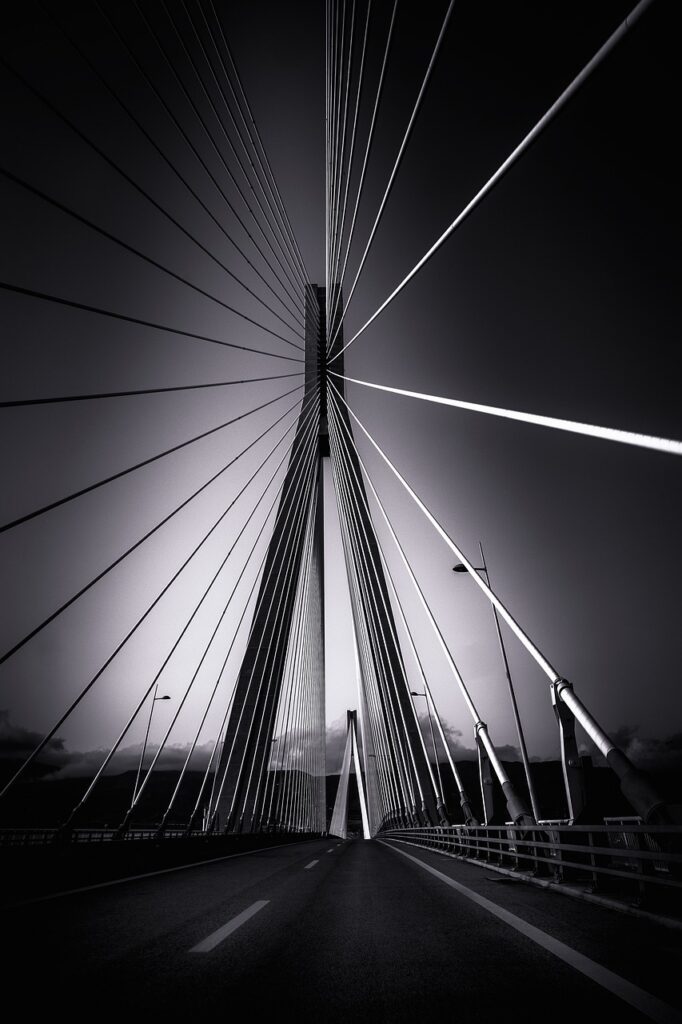The Rion-Antirion Bridge is one of my favourite structures. It’s an awe-inspiring construction project that leaves you mesmerised by its magnificence. Its engineering, especially considering the time of its construction, is mind-boggling. Built-in 1999, the Rion-Antirion Bridge spans the Gulf of Corinth near Patras, connecting the town of Rio on the Peloponnese peninsula to Antirion on mainland Greece. It’s not the structure that makes it an incredible feat of engineering; it’s the challenging conditions under which it was built. This article will explore how engineers overcame impossible challenges using ingenuity, innovative design, and cutting-edge technology to make this bridge possible.
Challenges:
The area presented several problems, including high-speed winds, deep water (with the bridge crossing waters up to 65m deep), and, most importantly, seismic activity. Constructing a bridge in one of the world’s most seismic-affected areas seemed daunting and pretty much impossible. To address these challenges, engineers had to consider multiple factors, such as:
Foundation concepts: Various foundation concepts were examined to ensure stability and prevent the sinking or failure of the bridge’s foundations.
Span type: The choice between suspension and cable-stayed spans had to be carefully evaluated, considering both economic feasibility and technical soundness.
Seismic activity: The seismic activity in the area caused additional problems that needed to be addressed:
- Soil liquefaction. This means the soil would temporarily lose its strength and start acting like a liquid when an earthquake happens, potentially sinking the bridge or failing its foundations.
- Ground shaking. The ground shaking would cause the bridge to start moving in ways it wasn’t designed to do, potentially leading to collapse.
- Ground displacement. Earthquakes can cause the ground to move in various ways, including sideways and vertical uplifts. These movements had to be accounted for in the design of the bridge.
Design and Overcoming Challenges:
Overcoming these challenges required innovative approaches and the use of cutting-edge technology. Here are some of the solutions that were implemented:
Stable foundation: Due to the deep water and unstable seabed, engineers drove piles 60 meters into the seabed. These piles provided a sound foundation for the bridge and could withstand lateral movement. Topping the piles with a 3-meter-thick layer of gravel allowed the piers to sit and move freely without toppling over.
Suspension system: Four concrete piers placed at the seabed, ranging in height from 48m to 63.5m, are connected by 386 cables. This arrangement gives the bridge its distinct look and has become a symbol of modern-day Greece. The bridge deck is suspended from these cables, allowing it to move freely with the forces of nature without exerting additional loads on the structure. The piers were designed to be flexible, swaying with the motion of earthquakes as they are not directly connected to the piles below them. In 2006, external dampers were installed near the bottom of the anchorage to improve the behaviour of the cables, increasing the overall damping of the cable system.
Viscous dampers: The hanging bridge deck posed a new challenge – the possibility of colliding with the pylons during excessive movement. To address this, engineers installed viscous dampers, the largest in the world at the time, at the pylon locations and transition piers. These dampers limit lateral displacements between the deck and the pylons, dissipating significant energy during seismic activity. They come into action only when the fuse restrainer parallel to them is triggered, which occurs at a magnitude of 10,500 KN during intense seismic activity. This design choice was made considering the frequent strong winds and low-level earthquakes experienced in the Gulf of Corinth, preventing excessive lateral movement of the bridge deck and ensuring its usability.

In conclusion, the Rion-Antirion Bridge is a testament to human innovation and engineering ingenuity. Despite seeming impossible, it was achieved by pushing the boundaries of engineering. Today, it symbolizes Greece’s progress and serves as a reminder of what can be accomplished when engineering challenges are overcome.
